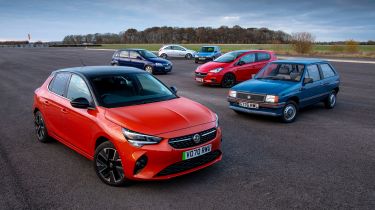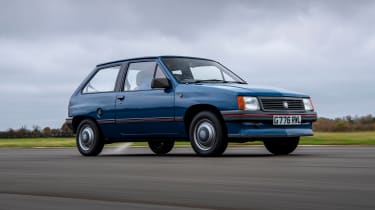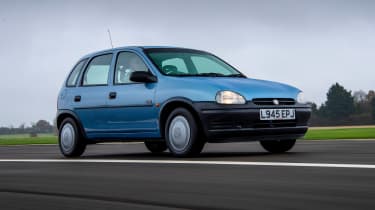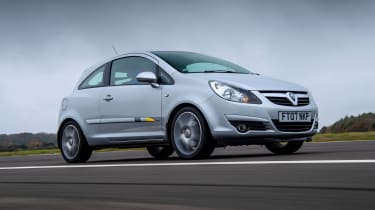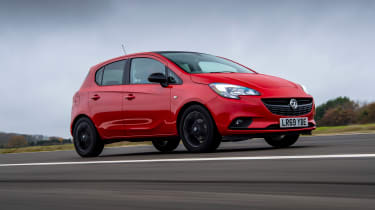40 years of Vauxhall Corsa: group test review
The Nova spawned Vauxhall's big-selling small car - the Corsa. To celebrate its 40th anniversary we drive every iteration of the popular supermini
It's often said that through six degrees of separation of friends and colleagues, it’s possible for any of us to draw a link to a famous celebrity. That might pass some fun for a few minutes, but there’s a much easier game to play if you’re a car geek. Ask almost anyone in the UK if they have a link to any one of the many generations of Vauxhall Corsa, and you’re likely to need one step at most. Whether you’ve driven one, owned one, or know a friend or relative who had one, we nearly all have a story about Vauxhall’s most popular model.
It’s a car that has formed a big part of many motoring lives, and now it’s our chance to pay the Corsa back by sharing its own story. With 2022 marking the 40th birthday of the name, there’s no better time to celebrate. Six different models – the first of which was badged Nova in the UK, but Corsa in the rest of Europe – and more than 13.5 million sales worldwide since its first release (with almost 2.8 million in the UK alone), we’ve gathered one of each generation together to look back on their influence, sample what each car feels like today, and line them up alongside the latest all-electric model to see how far the Corsa has come.
Vauxhall Nova
| Years built: | 1982-1993 |
| Engines: | 1.0-1.6-litre 4cyl petrol, 1.5-litre 4cyl diesel |
| Power: | 44bhp-99bhp |
| Number sold in UK: | 514,811 |
| Used values: | £2,500-£15,000 |
The car that started it all couldn’t come soon enough for Vauxhall. In the late seventies and early eighties, it needed a car to replace its ageing Chevette; the packaging compromise brought by its rear-wheel-drive layout meant that it struggled to keep pace with more modern competition such as the Ford Fiesta. The Nova’s release put Vauxhall right into the mix. Here was a conventional front-wheel-drive supermini that set the formula for every Corsa since.
Used - available now

2023 Vauxhall
Corsa
42,512 milesManualPetrol1.2L
Cash £9,300
2019 Vauxhall
Corsa
32,302 milesManualPetrol1.4L
Cash £9,490
2021 Vauxhall
Corsa
62,013 milesManualDiesel1.5L
Cash £9,687
2022 Vauxhall
Corsa
6,379 milesAutomaticPetrol1.2L
Cash £15,100In many ways, drive a Nova today and it feels every bit its 40 years. The driving position is all out of kilter; the pedals are offset to the left, as is the steering wheel, which is also angled a couple of degrees towards the centre of the car. The base of the windscreen is so close that you can reach out and touch it without moving in your seat. The skinny pillars all round won’t offer much crash safety, but allow for incredible all-round visibility.
It’s the only car here to use a manual choke, a feature that will be totally alien to many younger drivers. Pull it a touch when starting from cold and the engine fires into life easily. Nudge the delicate lever of the four-speed manual gearbox into first, release the skinny handbrake and the Nova creeps away with a minimum of fuss.
Power is in short supply – this 1.2 Merit model makes just 54bhp – but at 755kg, there isn’t much mass to move around. There’s always a great deal of enjoyment to be taken from driving a car that was developed four decades ago, and charm is something that the Nova has in spades.
Ease of maintenance meant that not only could owners service their cars at home, but enthusiastic drivers could also tune them, and the Nova becoming an icon of the modified car scene. Many of those cars succumbed to wild fibreglass add-ons and untimely ends as part of the over-exuberant boy racer culture of the day, so values of clean, original Novas have started to climb. On the rare occasions that hot editions like the Nova SR, GTE or facelifted GSi hit the market today, they’re priced at anywhere from £10,000-£15,000.
Owner's opinion
The car we have here was kindly provided to us by Graeme Wilkinson, and it’s surely one of the most immaculate examples on the road. With Vauxhalls the car of choice for Graeme’s family when he was growing up, the Nova is a car with sentimental value, and it’s been treated accordingly.
It was broken out of storage especially for our shoot, and behaved impeccably on the road. If you fancy a
little bit of Nova nostalgia, you’re in luck, because Graeme is reluctantly selling this car. At the time of going to press, it’s still for sale – if you’re interested, you can get in touch with him via E-mail at info@gmdetailing.uk.
Vauxhall Corsa B
| Years built: | 1993-2000 |
| Engines: | 1.0-litre 3cyl-1.6-litre 4cyl petrol, 1.5-litre-1.7-litre 4cyl diesel |
| Power: | 44bhp-108bhp |
| Number sold in UK: | 600,616 |
| Used values: | £500-£2,500 |
Vauxhall saw fit to revolutionise its small car for the nineties. As well as using Opel’s Corsa name for the first time, the styling was completely suited to the decade. Gone were the Nova’s eighties-tastic box arches and square edges, replaced entirely with a softer and rounder look.
The Corsa B grew larger in every dimension compared with the Nova, so there was more room inside and space to fit in the improved safety features. Side-impact protection was fitted for the first time, while ABS brakes and a driver’s airbag were available on some higher-spec models.
The GLS trim we have here missed out on the airbag, instead getting a very appealing and simple two-spoke steering wheel. The cabin feels much larger than the Nova’s; the driving position is more natural (cramped pedal box aside) and although the window line is higher, there’s still plenty of glass in order to easily judge the car’s compact dimensions. This example, owned by Vauxhall, has covered just 22,000 miles, and the 1.4-litre petrol engine feels more than up to the task of keeping pace with modern traffic.
The progress beyond the Nova is clear, even through the little details; every shift of the five-speed manual gearbox (one ratio more than the Nova) hits home with a more rubbery and better-damped action, and on the move it’s more hushed and relaxed, with less buzziness from the engine and reduced wind noise from the door pillars. The power-assisted steering is slow, but feels well suited to the easy-going nature of the rest of the car.
It’s no wonder that the Corsa became such a common sight on our roads. Today, numbers are much smaller. More than 10,000 Corsas of each generation were removed from our roads in the 2009 scrappage scheme, with the earliest model now proving to be the rarest. As a result, an immaculate example of even an entry-level model could command over £2,000 on the used market.
Our story
I was first acquainted with Vauxhall’s second-generation supermini two weeks after my 17th birthday. The white five-door was fitted with two very familiar Corsa B modifications: dual pedals and a set of L-plates, and it was behind its two-spoke steering wheel that I ventured out on to the road for the first time. It really was the ideal driving-school car, with tremendous visibility, light controls and a tight turning circle – perfect for those challenging first few three-point turns.
Vauxhall Corsa C
| Years built: | 2000-2006 |
| Engines: | 1.0-litre 3cyl-1.8-litre 4cyl petrol, 1.3-1.7-litre 4cyl diesel |
| Power: | 59bhp-123bhp |
| Number sold in UK: | 566,341 |
| Used values: | £300-£4,000 |
The dawn of the 21st Century saw the birth of the Corsa C, which once again raised the ante when it came to performance, efficiency and safety features. A driver’s airbag was now standard throughout the range, and longevity was improved; that new sharper face hid a body that was fully galvanised to help with corrosion protection.
We sampled a mid-range 1.4-litre Active, an immaculate example with just 30,000 miles on the clock. The Active benefitted from modern features such as air-conditioning and Isofix child seat points as standard, while this version was fitted with an automatic gearbox.
Even using the selector is a satisfyingly tactile experience – the skinny lever, also used in the Corsa B auto, clicks lightly from Park through to Drive. The car feels as wieldy as its predecessor – it only grew by 79mm in length – yet feels much sturdier. There’s also no longer any need to contort yourself awkwardly; a great deal of attention was paid to the ergonomics, so the driving position is much more comfortable, if not quite as adjustable as in the latest version.
Build up the revs as the auto slurs through its ratios, and the 88bhp petrol engine is noisier than in the current Corsa, but you won’t really mind, because it has a pleasing growl.
The 1.4 was part of an overhauled engine line-up that kicked off with a 1.0-litre three-cylinder petrol unit and topped out with a 1.8-litre four-cylinder in the SRi; this helped the Corsa crack the eight-second mark in the 0-62mph sprint. Direct-injection diesel models complied with Euro 4 emissions standards, yet turbocharging provided a decent shove of torque, too.
Owner's opinion
Dave Green’s Corsa C must be among the best-kept examples on the road today. It actually belongs to his mum, Joy, and is slightly more sensible than Dave’s own tuned Corsa C and his Tigra Mk2, both of which push out roughly 300bhp. “The family have owned Vauxhall cars since the late fifties,” Dave said, explaining his passion for the brand. “It’s a great all-rounder – as happy on the open road as it is in town, plus it’s still quite small.”
Vauxhall Corsa D
| Years built: | 2006-2014 |
| Engines: | 1.0-litre 3cyl-1.6-litre 4cyl turbo petrol, 1.3-1.7 litre-4cyl diesel |
| Power: | 59bhp-192bhp |
| Number sold in UK: | 704,951 |
| Used values: | £500-£12,000 |
Park the Corsa D beside the C, and it almost looks like a car from a larger sector – not surprising, since the car grew by a greater amount here than at any other point in the model’s history. Vauxhall also sought to create more differentiation between three and five-door models, with the latter featuring a taller roofline. Practicality took a big step up as a result.
With more than 700,000 finding homes in the UK, it’s a face we’ve all become familiar with. It’s softer than the C, although the three-door we have here had a sportier profile that formed a great basis for the VXR hot hatch. Prod the plastic interior trim and it feels its age, and there’s no fancy digital instruments or touchscreen – just a simple dot-matrix display to show you chosen FM/AM radio station, and a set of gently backlit analogue dials. The driving position is quite high, which gives a great view ahead when manoeuvring at low speeds.
It’s clear that refinement was a focus; in terms of comfort, the Corsa D still stands up well to any current supermini. Other areas have dated much more, though. The steering feels slow and heavy, and this car’s 90bhp 1.3-litre diesel is clattery.
It was frugal, though, returning almost 60mpg in the older-style NEDC official tests. Other versions benefitted from fuel-saving stop/start technology, too.
Overall, the car feels more substantial than past Corsas, so a long motorway slog isn’t the daunting task it once was.
Owner's opinion
Chairman of the Vauxhall, Bedford and Opel Vehicles Club, Shaun Broadbent’s Corsa D has lived a busy life since it fell into his hands last year. The odometer is now nudging a remarkable 174,000 miles, and the car is still used regularly. “I bought it as a runaround due to the high mileage I drive,” says Sean, something which helps keep the miles off other rarer classic Vauxhalls in his collection. “The only cost I have had was for new front discs and pads. It passed its MoT this year with no advisories, and I’m averaging around 450 miles on a [44-litre] tank, which is great.”
Vauxhall Corsa E
| Years built: | 2014-2019 |
| Engines: | 1.0-litre 3cyl-1.6-litre 4cyl turbo petrol, 1.3-litre 4cyl diesel |
| Power: | 74bhp-202bhp |
| Number sold in UK: | 322,239 |
| Used values: | £2,000-£15,000 |
Paris was the location for the reveal of the fifth-generation Corsa E, a car which, at first glance, shared similarities with its older brother. The previous model’s platform was retained, and features such as the glasshouse and roof were carried over.
However, the Corsa E moved the game on drastically, not least inside, where a complete cabin overhaul introduced a new dashboard layout (including lashings of piano black plastic trim), a contemporary steering wheel and a touchscreen infotainment system – the inclusion of Apple CarPlay and Android Auto on later cars going some way to future-proof the set-up. As before, cabin space was one of the Corsa’s greatest selling points compared with the competition. A 285-litre boot also ensured practicality was well catered for.
What the Corsa E did more than anything else is transform the driving experience compared with its predecessor. It’s obvious that its recalibrated steering system delivers a much more natural response. The steering weight is not only lighter, but it makes this Corsa feel much more fun to drive than its predecessor. Ride comfort, already one of the stronger aspects of the earlier model, took a step forward, too – although by the standards of the latest car, it’s now showing its age.
The introduction of a 1.0-litre turbocharged three-cylinder petrol engine considerably modernised the petrol line-up, too, delivering more punch than the previous 1.4-litre unit, while boosting refinement and efficiency.
Our story
I had to wait a little longer than most for my Corsa story. It came at the ripe old age of 27; my very first Auto Express long-termer was a 2014 lime-green Corsa Excite.
As well as driving it in and out of the office every day for six months, I also took it on a rather unlikely 900-mile round-trip to Knockhill Circuit in Scotland for the launch of the Corsa VXR hot hatch.
While I expected my Corsa to feel out of its depth sitting at 70mph on the M6, the peppy 113bhp engine made light work of the journey. It cost me buttons to run, too.
I truly gelled with the Corsa on that trip. You learn a lot sitting behind the wheel for eight hours – and it’s a car I still look back on now with fond memories.
Vauxhall Corsa F
| Years built: | 2019-present |
| Engines: | 1.2-litre 3cyl turbo petrol, 1.5-litre 4cyl diesel, single e-motor |
| Power: | 75bhp-134bhp |
| Used values: | From £17,015 |
A clean-sheet design was required for the sixth-generation Corsa, the first to be developed after Vauxhall-Opel’s merger with the PSA Group, and now part of the larger Stellantis corporation. There’s an interesting story to tell, though, because a new Corsa was being developed by previous owner General Motors, but it was scrapped at the 11th hour following the merger. It meant the current Corsa moved to the latest group CMP platform, opening up the ability to install a new range of power units. These included the latest turbocharged petrol and diesel variants plus, crucially, a fully electric drivetrain.
What strikes you immediately with the latest Corsa is just how much more modern it feels even when compared with its direct predecessor. From the outside, it’s grown slightly longer, but wider and lower too, offering a much sportier stance. Inside, the cabin feels better finished, and the minimalist design looks more contemporary, while the technology has had a serious upgrade.
The biggest area of improvement comes from that electric powertrain, though. The 134bhp motor of the Corsa-e in our pictures feels so smooth, quiet and quick beside any of its predecessors, yet it looks identical to the latest combustion-powered line-up. Better still, its zero emissions are an ideal quality for a car that will probably
cover most of its mileage in urban areas, while its 50kWh battery offers a WLTP-certified range of up to 209 miles.
The line-up still continues with petrol and diesel options – which are cheaper to buy and have their own appeal – but this is the best of the bunch to drive.
Our story
In late 2019 I flew to Croatia to sample the all-new Corsa. Launches hosted in beautiful countries always need a bit of expectation management, and sometimes cars aren’t quite as impressive when we get them back to the UK. But what was immediately clear with the Corsa was just how much of an improvement it was over its predecessor. Interior quality, refinement and in-car tech all took a huge leap. It’s no surprise that it’s become a sales hit.

